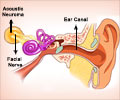Partial hearing loss could be effectively addressed by a new hybrid cochlear implant, it has been shown.
Partial hearing loss could be effectively addressed by a new hybrid cochlear implant, it has been shown.
The device aims to restore hearing for individuals with high-frequency hearing loss and functional low-frequency hearing.This group of patients doesn’t meet the criteria for conventional cochlear implants because they have near perfect residual hearing in low pitches that allows them to perform well on tests used to determine candidacy for traditional implants. However, their hearing in high pitches is so poor that a hearing aid is not helpful, making them ideally suited for the hybrid implant which addresses both issues.
Northwestern Memorial Hospital is one of nine centers in the U.S that are participating in a study investigating the effectiveness of the new cochlear implant.
“We are hopeful that the hybrid cochlear implant will provide a subset of people who were previously not candidates for an implantable device the opportunity to test the device to determine if they can experience sound again,” said Northwestern Medicine neurotologist Andrew Fishman, MD, principal investigator of the study, staff in the departments of otolaryngology and neurosurgery at Northwestern University’s Feinberg School of Medicine, and Mr. Groves’ cochlear implant surgeon. “The potential for patients with a significant amount of residual hearing, but a large amount of high-frequency hearing loss, to have an alternative to hearing aids would be a great improvement to what is currently available.”
Cochlear implants were FDA approved in 1984 as a treatment option for restoring hearing in people with severe and profound hearing loss. The surgical implant system is designed to stimulate the auditory nerve by bypassing damaged parts of the ear. A small battery-operated mini “computer” and microphone are worn on the outside of the ear and convert sounds into electric signals. The signals are then transmitted to implant electrodes in the cochlea, which stimulate the nerve endings so sound can be perceived by the brain.
The hybrid cochlear implant works in the same way as traditional cochlear implants, stimulating nerve endings in the cochlear so that high-pitched sounds can be heard. In addition, it also involves amplification for low-pitched sounds, similar to a hearing aid. Like traditional cochlear implants, the hybrid version is worn outside the ear and converts sounds into acoustic and electric signals.
Advertisement
Post-activation evaluations take place at three, six and 12 months following the initial activation process to assess progress of the cochlear implant. An audiologist will also test the implant to determine if participants are able to understand words, sentences in noisy and quiet environments, as well as music recognition.
Advertisement
Source-Medindia









